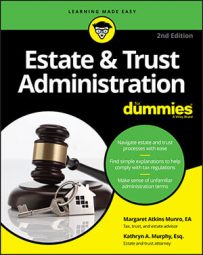After you put the sum of lines 1a through 1c on Schedule G, line d, you’re ready to see whether you can reduce your tax with tax credits. Tax credits are dollar-for-dollar amounts that you subtract from your tax liability; they’re better than deductions. Estates and trusts aren’t eligible for most tax credits that individuals can take, and no credit on Form 1041 can reduce the tax liability below zero.
However, on lines 2a through 2d of Schedule G, you have the opportunity to reduce the trust or estate’s tax liability with the following credits:
Foreign tax credit:You’re entitled to take a credit for taxes you’ve paid to a foreign country with whom the United States has a tax treaty (a few exceptions such as Iraq, Iran, and North Korea). If the amount of foreign taxes paid is $300 or less, you can just fill in the amount actually paid on line 2a.
However, if the amount is greater than $300, you have to become acquainted with Form 1116, Foreign Tax Credit. The IRS knows this form is evil, and estimates it should take you about seven hours to complete. If you made income distributions to beneficiaries during the year, you should allocate the applicable portion of the foreign tax credit to the beneficiary as his or her percentage share of the total.
Form 1116 has been known to bring even the most brilliant accountants to their knees. If you need to attach one of these forms to your return, especially if you have large amounts of qualified dividends or long-term capital gains, you may want to consult a professional here.
General business credits: Enter the total of all the general business credits the trust or estate is entitled to on Form 3800, General Business Credit, on line 2c of Schedule G. If you made income distributions during the year, be careful not to include any credits on Form 1041 that are allocable to the income beneficiary.
Credit for prior year minimum tax: If the trust or estate paid AMT in a prior year, it may be eligible to reclaim some part of that tax on Schedule G, line 2d. Complete Form 8801, Credit for Prior Year Minimum Tax – Individuals, Estates and Trusts to see whether this return qualifies.
Credit to holders of tax credit bonds: Certain types of loans for items such as clean, renewable energy; Midwestern tax credits; forestry conservation bonds; energy conservation bonds; school construction bonds; and the always-popular Build America Bond allow the taxpayer to take a credit instead of receiving all, or a portion, of the interest that would be earned on that loan.
Not all bonds qualify, but your broker will know and should label these securities as such. You should receive Form 1099-BTC, Bond Tax Credit, reporting these credits to you. Complete Form 8912, Credit to Holders of Tax Credit Bonds, and enter the amount on line 12 on Form 1041, Schedule G, line 2d.

